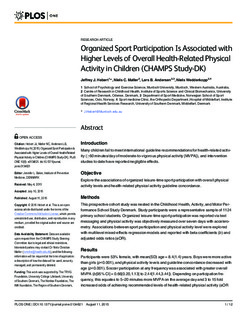| dc.contributor.author | Hebert, Jeffrey J. | |
| dc.contributor.author | Møller, Niels C. | |
| dc.contributor.author | Andersen, Lars Bo | |
| dc.contributor.author | Wedderkopp, Niels | |
| dc.date.accessioned | 2016-05-25T12:24:42Z | |
| dc.date.available | 2016-05-25T12:24:42Z | |
| dc.date.issued | 2015-08-11 | |
| dc.identifier.citation | PLoS ONE. 2015, 10, 8 | nb_NO |
| dc.identifier.uri | http://hdl.handle.net/11250/2390412 | |
| dc.description | © The Author(s) 2015 Open Access This article is distributed under the terms of the Creative Commons Attribution-NonCommercial 4.0 International License (http://creativecommons.org/licenses/by-nc/4.0/), which permits any noncommercial use, distribution, and reproduction in any medium, provided you give appropriate credit to the original author(s) and the source, provide a link to the Creative Commons license, and indicate if changes were made. | nb_NO |
| dc.description.abstract | Introduction:
Many children fail to meet international guideline recommendations for health-related activity (≥60 minutes/day of moderate-to-vigorous physical activity [MVPA]), and intervention studies to date have reported negligible effects.
Objective:
Explore the associations of organized leisure-time sport participation with overall physical activity levels and health-related physical activity guideline concordance.
Methods:
This prospective cohort study was nested in the Childhood Health, Activity, and Motor Performance School Study Denmark. Study participants were a representative sample of 1124 primary school students. Organized leisure-time sport participation was reported via text messaging and physical activity was objectively measured over seven days with accelerometry. Associations between sport participation and physical activity level were explored with multilevel mixed-effects regression models and reported with beta coefficients (b) and adjusted odds ratios (aOR).
Results:
Participants were 53% female, with mean(SD) age = 8.4(1.4) years. Boys were more active than girls (p<0.001), and physical activity levels and guideline concordance decreased with age (p<0.001). Soccer participation at any frequency was associated with greater overall MVPA (b[95% CI] = 0.66[0.20,1.13] to 2.44[1.44,3.44]). Depending on participation frequency, this equates to 5–20 minutes more MVPA on the average day and 3 to 15 fold increased odds of achieving recommended levels of health-related physical activity (aOR[95%CI] = 3.04[1.49,6.19] to 14.49[1.97,106.56]). Similar associations were identified among children playing handball at least twice per week. Relationships with other sports (gymnastics, basketball, volleyball) were inconsistent.
Conclusions:
Many children, particularly girls and those in higher grade levels do not adhere to health-related physical activity recommendations. Organized leisure-time sport participation may be a viable strategy to increase overall health-related physical activity levels and international guideline concordance in children. | nb_NO |
| dc.language.iso | eng | nb_NO |
| dc.publisher | Public Library of Science (PLoS) | nb_NO |
| dc.subject | physical activity | nb_NO |
| dc.subject | sports | nb_NO |
| dc.subject | exercise | nb_NO |
| dc.subject | schools | nb_NO |
| dc.subject | children | nb_NO |
| dc.subject | accelerometers | nb_NO |
| dc.subject | global health | nb_NO |
| dc.subject | child health | nb_NO |
| dc.title | Organized sport participation is associated with higher levels of overall health-related physical activity in children (CHAMPS study-DK) | nb_NO |
| dc.type | Journal article | nb_NO |
| dc.type | Peer reviewed | nb_NO |
| dc.subject.nsi | VDP::Mathematics and natural science: 400 | nb_NO |
| dc.subject.nsi | VDP::Mathematics and natural science: 400::Basic biosciences: 470 | nb_NO |
| dc.subject.nsi | VDP::Agriculture and fishery disciplines: 900 | nb_NO |
| dc.subject.nsi | VDP::Agriculture and fishery disciplines: 900::Agriculture disciplines: 910 | nb_NO |
| dc.source.journal | PLoS ONE | nb_NO |
| dc.description.localcode | Seksjon for idrettsmedisinske fag / Department of Sport Medicine | nb_NO |
